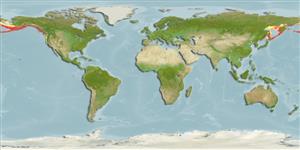Preferred temperature (Ref.
123201): 1 - 7.6, mean 4.1 °C (based on 434 cells).
Phylogenetic diversity index (Ref.
82804): PD
50 = 1.2500 [Uniqueness, from 0.5 = low to 2.0 = high].
Bayesian length-weight: a=0.00389 (0.00180 - 0.00842), b=3.12 (2.94 - 3.30), in cm total length, based on all LWR estimates for this body shape (Ref.
93245).
Trophic level (Ref.
69278): 4.0 ±0.3 se; based on diet studies.
Widerstandsfähigkeit (Ref.
120179): mittel, Verdopplung der Population dauert 1,4 - 4,4 Jahre. (Fec = 1,000).
Fishing Vulnerability (Ref.
59153): Low vulnerability (21 of 100).
🛈
Nutrients (Ref.
124155): Calcium = 37.4 [21.5, 86.2] mg/100g; Iron = 0.497 [0.205, 0.989] mg/100g; Protein = 17.3 [15.6, 19.0] %; Omega3 = 0.262 [0.135, 0.511] g/100g; Selenium = 15.3 [6.1, 34.6] μg/100g; VitaminA = 21.2 [4.5, 99.9] μg/100g; Zinc = 0.417 [0.274, 0.627] mg/100g (wet weight); based on
nutrient studies. 